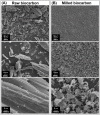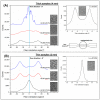The Influence of the Hybridization Process on the Mechanical and Thermal Properties of Polyoxymethylene (POM) Composites with the Use of a Novel Sustainable Reinforcing System Based on Biocarbon and Basalt Fiber (BC/BF)
- PMID: 32784725
- PMCID: PMC7475888
- DOI: 10.3390/ma13163496
The Influence of the Hybridization Process on the Mechanical and Thermal Properties of Polyoxymethylene (POM) Composites with the Use of a Novel Sustainable Reinforcing System Based on Biocarbon and Basalt Fiber (BC/BF)
Abstract
The presented work focuses on the assessment of the material performance of polyoxymethylene (POM)-based composites reinforced with the use of a biocarbon/basalt fiber system (BC/BF). The use of BC particles was aimed at eliminating mineral fillers (chalk, talc) by using fully biobased material, while basalt fibers can be considered an alternative to glass fibers (GF). All materials were prepared with the same 20% filler content, the differences concerned the (BC/BF) % ratio. Hybrid samples with (25/75), (50/50), and (75/25) ratios were prepared. Additionally, reference samples were also prepared (POM BC20% and POM BF20%.). Samples prepared by the injection molding technique were subjected to a detailed analysis of mechanical properties (static tensile and Charpy impact tests), thermomechanical characteristics (dynamic mechanical thermal analysis-DMTA, heat deflection temperature - HDT), and thermal and rheological properties (DSC, rotational rheometer tests). In order to assess fiber distribution within the material structure, the samples were scanned by a microtomography method (μCT). The addition of even a significant amount of BC particles did not cause excessive material brittleness, while the elongation and impact strength of all hybrid samples were very similar to the reference POM BF20% sample. The tensile modulus and strength values appear to be strictly dependent on the increasing BF fiber content. Thermomechanical analysis (DMTA, HDT) showed very similar heat resistance for all hybrid samples; the results did not differ from the values for the POM BF20 sample.
Keywords: basalt fiber (BF); biocarbon (BC); hybrid composite; mechanical performance; structure orientation.
Conflict of interest statement
The authors declare no conflict of interest. The funders had no role in the design of the study; in the collection, analyses, or interpretation of data; in the writing of the manuscript, or in the decision to publish the results.
Figures











References
-
- Inman M., Thorhallsson E.R., Azrague K. A Mechanical and Environmental Assessment and Comparison of Basalt Fibre Reinforced Polymer (BFRP) Rebar and Steel Rebar in Concrete Beams. Energy Procedia. 2017;111:31–40. doi: 10.1016/j.egypro.2017.03.005. - DOI
-
- Azrague K., Inman M.R., Alnæs L.-I., Schlanbusch R.D., Jóhannesson B. Life Cycle Assessment as a tool for resource optimisation of continuous basalt fibre production in Iceland; Proceedings of the Life Cycle Assessment and Other Assessment Tools for Waste Management and Resource Optimization; Cetraro, Italy. 5–10 June 2016.
-
- Sigfusson T.I., Jóhannesson B. Sustainable Fibres from Basalt Mining GREENBAS; Proceedings of the NordMin Workshop; Helsinki, Finland. 20 October 2016.
-
- Gkaidatzis R. Master’s Thesis. Delft University of Technology; Delft, The Netherlands: 2014. Bio-Based FRP Structures: A Pedestrian Bridge in Schiphol Logistics Park.
-
- Pulidindi K., Panday H. Polyoxymethylene (POM) Market. [(accessed on 7 August 2020)]; Available online: https://www.gminsights.com/industry-analysis/polyoxymethylene-pom-market.
Grants and funding
LinkOut - more resources
Full Text Sources
Miscellaneous

